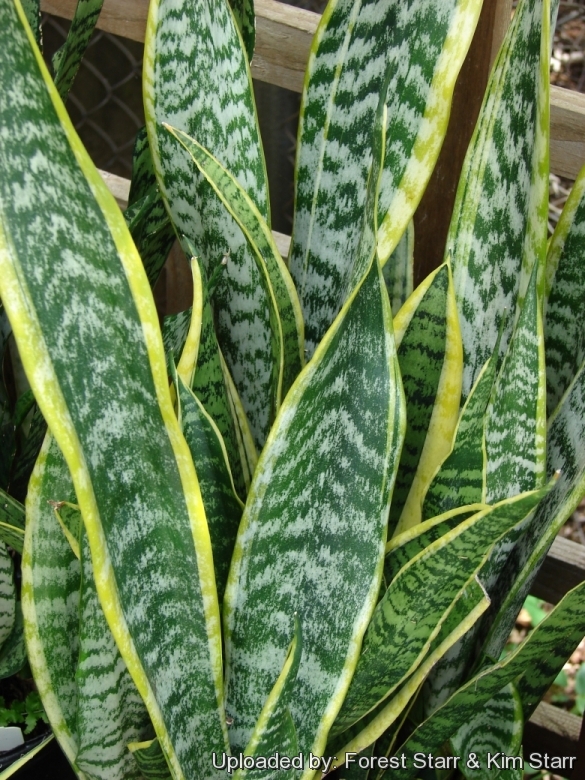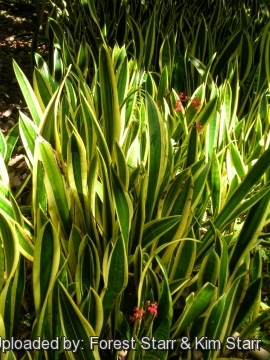= Sansevieria trifasciata cv. Laurentii
Accepted Scientific Name: Sansevieria trifasciata Prain
Bengal Pl. 2: 1054. 1903 Prain

Sansevieria trifasciata var. laurentii (Sansevieria trifasciata cv. Laurentii) Photo by: Forest Starr & Kim Starr
Habit at Kula Ace Hardware and Nursery, Maui, Hawaii, USA. September 06, 2007.
Origin and Habitat: Garden origin. The natural species is native to to tropical West Africa from Nigeria east to the Congo.
Synonyms:
See all synonyms of Sansevieria trifasciata
back
Accepted name in llifle Database:Sansevieria trifasciata PrainBengal Pl. 2: 1054. 1903Synonymy: 3
Cultivars
(5):
back
Common Names include:
ENGLISH: Mother-in-laws Tongue, Jinn's tongue, Bow string hemp, Snake tongue, Saint George's sword, Devil's tongue, Snake plant, Stripped Snake plant, Striped Mother-in-law's Tongue
RUSSIAN (Русский): Сансевьера треxполосная ‘Лаурентии’
Description: Sansevieria trifasciataSN|19026]]SN|19026]] cv. Laurentii (a.k.a. "Stripped Snake plant" or "Striped Mother-in-law's Tongue") is a stemless perennial succulent herb forming dense stands, spreading by way of its creeping rhizome. Its sword-shaped succulent leaves grow upright from a basal rosette, and are rigid, deep green with horizontal bands of light greyish-green and bordered with a creamy yellow margin of variable width which is parallel with the veins of the leaf. It is one of the most commonly grown indoor and tropical garden ornamental plants. Flowers greenish white, to 1 cm long, clustered on a raceme to 75 cm long.
Rhizome: Sympodial, sometimes above ground, sometimes underground, robust, and yellowish 1.3 to 2.5 cm thick.
Leaves: 1–2(rarely to 6), vertical, very erect, linear-lanceolate and flat, tappering gradually from the middle or above, fibrous, fleshy, 45-to over 1 m tall, 5-7 cm wide, and channelled at the base, banded on both surfaces from base to apex, very distinct light dull green or clear whitish-green and deep grass-green to almost blackish-green, overspread with slight glaucous bloom, margins narrow, dull-green (var. trifasciata) or creamy-yellow (var. laurentii). The leaf surface is smooth.
Inflorescence (raceme): Erect (30–)40–75 cm high, loosely filled with three to eight flowers per bunch. Stalk 3–8 mm thick The bract is ovate or ovate-lanceolate, pointed, 3-12 mm long
Flowers:(1–)3–4 per cluster. Pedicels 50–85 mm long, upward-curved green with pale green dots. Flowers pale greenish or greenish-white, perianth is 1.9–2.3(-3)cm long, greenish-white, and scented. The sepals are linear and greenish. The stamens are 0.8 cm long and the style is 1.5 cm long.
Fruits (berries): Globose, 8-9 mm in diameter, bright orange, and contain 1-2(-3) seeds.
Chromosome number: 2n = 36.
Bibliography: Major references and further lectures
1) Urs Eggli “Illustrated Handbook of Succulent Plants: Monocotyledons: Monocotyledons” Springer Science & Business Media, 17 July 2001
2) Forest & Kim Starr “Sansevieria trifasciata (Mother in law's tongue, snake plant)”. Plants of Hawaii. <http://www.starrenvironmental.com>. Web. 1 Jan. 2015.
3) Wikipedia contributors. "Sansevieria trifasciata." Wikipedia, The Free Encyclopedia. Wikipedia, The Free Encyclopedia, 28 Oct. 2014. Web. 1 Jan. 2015.
4) Geoffrey Mwachala & Paul Mbugua “Flora of Tropical East Africa” 2007
5) Watt, J., and Breyer-Brandwijk, M., “The Medical and Poisonous Plants of Southern and Eastern Africa” E & S Livingstone, Edinburgh, 1962
6) Mitchell, J. and Rook, A., “Botanical Dermatology. Plants Injurious to the Skin.” Greengrass, Vancouver 1979
7) Spoerke, Susan C. Smolinske “Toxicity of Houseplants” CRC Press, 03 July 1990
8) Christophe Wiart “Medicinal Plants of China, Korea, and Japan: Bioresources for Tomorrow’s Drugs and Cosmetics” CRC Press, 11 May 2012
9) James Del Prince “Interior Plantscaping: Principles and Practices” Cengage Learning, 12 October 2012
10) Burkill, H.M. “The useful plants of west tropical Africa” Vol 3 1985.
11) Nicholas Edward Brown “Sansevieria - a monograph of all the known species (with plates).” In: Bulletin of Miscellaneous Information, Heft 5. Royal Botanic Gardens, Kew 1915, S. 239–241 (online).
12) Peter A. Mansfeld: “Die Gattung Sansevieria – Alle Arten und ihre Pflege.” BoD, Hamburg 2013
13) Urs Eggli, Leonard E. Newton: “Etymological Dictionary of Succulent Plant Names.” Birkhäuser 2004.
14) Jo Jarvis, “Foliage for Florists” 2006
 Habit at Enchanting Floral Gardens of Kula, Maui, Hawaii, USA. October 24, 2007. (Sansevieria trifasciata cv. Laurentii) Photo by: Forest Starr & Kim Starr
Habit at Enchanting Floral Gardens of Kula, Maui, Hawaii, USA. October 24, 2007. (Sansevieria trifasciata cv. Laurentii) Photo by: Forest Starr & Kim StarrSend a photo of this plant.The gallery now contains thousands of pictures, however it is possible to do even more. We are, of course, seeking photos of species not yet shown in the gallery but not only that, we are also looking for better pictures than those already present.
Read More... Cultivation and Propagation: Sansevieria trifasciataSN|19026]]SN|19026]] is slow-growing but easy to cultivate. It is a very drought tolerant plant, but not as cold hardy as some. It needs heat and dry air in Winter and half shade in Summer. Does best as a pot plant. Like all snake plants, it is very efficient in removing pollutants from indoor air.
Soil: Use a well-drained potting mix consisting of 3 parts loam to 1 part of pumice.
Fertilization: They are fertilized once during the growing season with a balanced fertilizer.
Repotting: Transplant only when plant is pot-bound.
Watering Needs: The plants are very drought tolerant and are watered about every other week during the growing season, allow to dry somewhat between waterings. During the winter months they are watered once a month.
Exposure: Bright filtered light. Will tolerate low light levels but grows best and flowers if given bright light and even tolerates full sun. Afternoon shade in summer.
Frost Tolerance: Avoid any frost. This species is dormant in winter, keep it at or around 4°C.
Outdoors: In the garden In mild to tropical climates it prefers semi-shade or shade and it is not fussy.
Aerosol salt tolerance: It is very tolerant of coastal and beach exposure.
Pests/Disease: Mealybugs and spider mites.
Use: It is a great container plant for interior or exterior use that needs little care. It makes a choice designer's architectural statement. It is popular as an ornamental plant as it is easy to culture and take care of in a home.
Propagation: They are propagated by cuttings or by divisions taken at any time. Cuttings should be at least 10 cm long and inserted in moist sand. A rhizome will emerge at the cut edge of the leaf. Variegated cultivars offspring will lack variegation if rooted from leaves.











